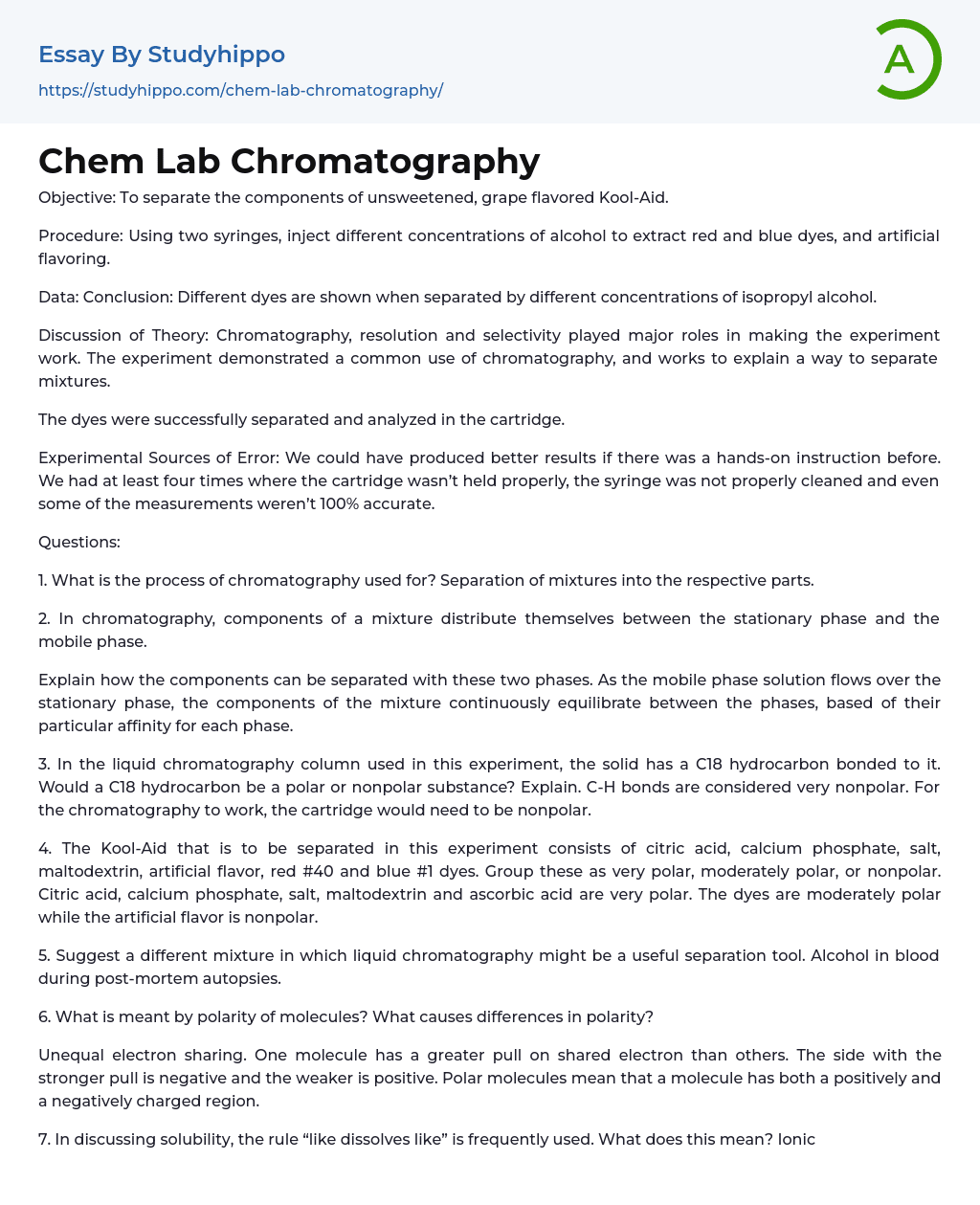Objective: To separate the components of unsweetened, grape flavored Kool-Aid.
Procedure: Using two syringes, inject different concentrations of alcohol to extract red and blue dyes, and artificial flavoring.
Data: Conclusion: Different dyes are shown when separated by different concentrations of isopropyl alcohol.
Discussion of Theory: Chromatography, resolution and selectivity played major roles in making the experiment work. The experiment demonstrated a common use of chromatography, and works to explain a way to separate mixtures.
The dyes were successfully separated and analyzed in the cartridge.
Experimental Sources of Error: We could have produced better results if there was a hands-on instruction before. We had at least four times where the cartridge wasn’t held properly, the syringe was not properly cleaned and even some of the measurements weren’t 100% accurate.
Q
...uestions:
1. What is the process of chromatography used for? Separation of mixtures into the respective parts.
2. In chromatography, components of a mixture distribute themselves between the stationary phase and the mobile phase.
Explain how the components can be separated with these two phases. As the mobile phase solution flows over the stationary phase, the components of the mixture continuously equilibrate between the phases, based of their particular affinity for each phase.
3. In the liquid chromatography column used in this experiment, the solid has a C18 hydrocarbon bonded to it. Would a C18 hydrocarbon be a polar or nonpolar substance? Explain. C-H bonds are considered very nonpolar. For the chromatography to work, the cartridge would need to be nonpolar.
4. The Kool-Aid that is to be separated in this experiment consists of citric acid, calcium phosphate, salt, maltodextrin, artificial flavor, red #40 and blue
#1 dyes. Group these as very polar, moderately polar, or nonpolar. Citric acid, calcium phosphate, salt, maltodextrin and ascorbic acid are very polar. The dyes are moderately polar while the artificial flavor is nonpolar.
5. Suggest a different mixture in which liquid chromatography might be a useful separation tool. Alcohol in blood during post-mortem autopsies.
6. What is meant by polarity of molecules? What causes differences in polarity?
Unequal electron sharing. One molecule has a greater pull on shared electron than others. The side with the stronger pull is negative and the weaker is positive. Polar molecules mean that a molecule has both a positively and a negatively charged region.
7. In discussing solubility, the rule “like dissolves like” is frequently used. What does this mean? Ionic and Polar substances dissolve ionic and polar substances and non-polar substances dissolve non-polar substances.
8. Draw the structural formula of isopropyl alcohol. Explain how it differs in polarity from water.
9. For good separation of the dyes, the resolution should be greater than one. What was the value you calculated? Did the two dyes overlap as they emerged from the column, or was the separation a good one? We got the resolution of 1. 18. The two dyes overlapped but showed a clear separation on their respective sides.
10. In the step gradient separation, four separate fractions were collected. How were these related to the polarities of the column and of the eluting solvent? They were the outcomes or eluted substances from the Kool-Aid. The polarities are the same as the percentage of alcohol used in the separation.
- Acid essays
- Calcium essays
- Carbohydrate essays
- Carbon essays
- Chemical Bond essays
- Chemical Reaction essays
- Chemical reactions essays
- Chromatography essays
- Concentration essays
- Copper essays
- Diffusion essays
- Ethanol essays
- Hydrogen essays
- Organic Chemistry essays
- Osmosis essays
- Periodic Table essays
- Ph essays
- Salt essays
- Sodium essays
- Titration essays
- John Locke essays
- 9/11 essays
- A Good Teacher essays
- A Healthy Diet essays
- A Modest Proposal essays
- A&P essays
- Academic Achievement essays
- Achievement essays
- Achieving goals essays
- Admission essays
- Advantages And Disadvantages Of Internet essays
- Alcoholic drinks essays
- Ammonia essays
- Analytical essays
- Ancient Olympic Games essays
- APA essays
- Arabian Peninsula essays
- Argument essays
- Argumentative essays
- Art essays
- Atlantic Ocean essays
- Auto-ethnography essays
- Autobiography essays
- Ballad essays
- Batman essays
- Binge Eating essays
- Black Power Movement essays
- Blogger essays
- Body Mass Index essays
- Book I Want a Wife essays




